by Eric Meier
When attempting to identify a wood sample, it’s important to keep in mind the limitations and obstacles that are present in our task. Before starting, please have a look at The Truth Behind Wood Identification to approach the task in a proper mindset; I consider the linked article to be required reading for all those visiting my site with the intent of identifying wood.
1. Confirm it is actually solid wood.
Before proceeding too much farther into the remaining steps, it’s first necessary to confirm that the material in question is actually a solid piece of wood, and not a man-made composite or piece of plastic made to imitate wood.
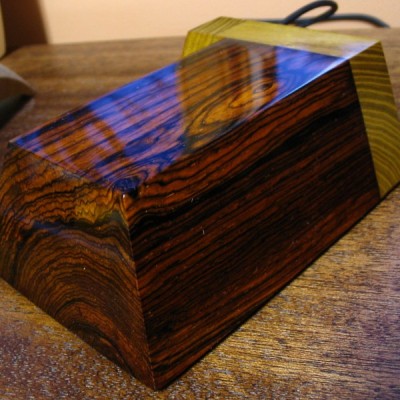
Can you see the end-grain?
Manufactured wood such as MDF, OSB, and particleboard all have a distinct look that is—in nearly all cases—easily distinguishable from the endgrain of real wood. Look for growth rings—formed by the yearly growth of a tree—which will be a dead-giveaway that the wood sample in question is a solid, genuine chunk of wood taken from a tree.
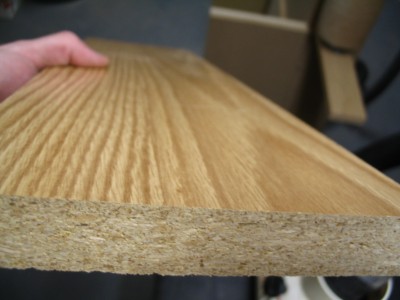
Is it veneered?
If you see a large panel that has a repeating grain pattern, it may be a veneer. In such cases, a very thin layer of real wood is peeled from a tree and attached to a substrate; sometimes the veneer can be one continuous repeating piece because it is rotary-sliced to shave off the veneer layer as the tree trunk is spun by machines. Assuming it is a real wood veneer with a distinct grain and texture—and not merely a piece of printed plastic—you may still be able to identify the outer veneer wood in question, but you should still realize that is it only a veneer and not a solid piece of wood.
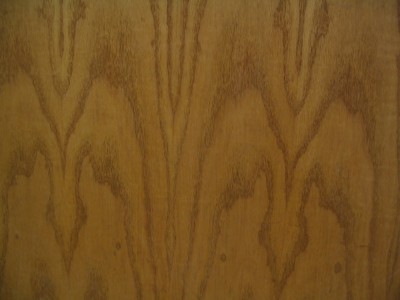
Is it painted or printed to look like wood?
Many times, especially on medium to large-sized flat panels for furniture, a piece of particleboard or MDF is either laminated with a piece of wood-colored plastic, or simply painted to look like wood grain. Many of today’s interior hardwood flooring planks are good examples of these pseudo-wood products: they are essentially a man-made material made of sawdust, glues, resins, and durable plastics.
2. Look at the color.
Some questions to immediately ask yourself:
Is the color of the wood natural, or is it stained?
If there is even a chance that the color isn’t natural, the odds are increased that the entire effort of identifying the wood will be in vain.
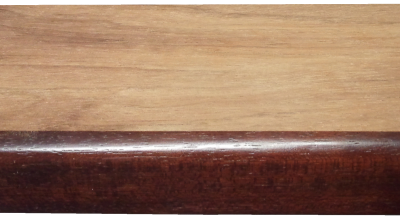
Is it weathered or have a patina?
Many woods, when left outside in the elements, tend to turn a bland gray color. Also, even interior wood also takes on a patina as it ages: some woods get darker, or redder, and some even get lighter or lose their color; but for the most part, wood tends to darken with age.
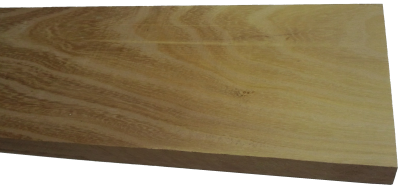
Is it possible to sand or plane the board to see the natural raw color of the wood?
The most predictable baseline to use when identifying wood is in a freshly sanded state. This eliminates the chances of a stain or natural aging skewing the color diagnosis of the wood.
3. Observe the wood grain.
If the wood is unfinished, then look at the texture of the grain. Ask yourself these questions:
Does the wood have an open, porous texture?
Most softwoods will be almost perfectly smooth with no grain indentations, while many common hardwoods have an open pore structure, such as oak or mahogany; though there are some hardwoods that are also smooth to the touch, such as maple.
Can you tell if the wood is quartersawn or plainsawn?
By observing the grain patterns, many times you can tell how the board was cut from the tree. Some wood species have dramatically different grain patterns from plainsawn to quartersawn surfaces. For instance, on their quartersawn surfaces, lacewood has large lace patterns, oak has flecks, and maple has the characteristic “butcher block” appearance.
Is there any figure or unusual characteristics, such as sapwood, curly or wild grain, burl/knots, etc.?
Some species of wood have figure that is much more common than in other species: for example, curly figure is fairly common in soft maple, and the curls are usually well-pronounced and close together. Yet when birch or cherry has a curly grain, it is more often much less pronounced, and the curls are spaced farther apart.
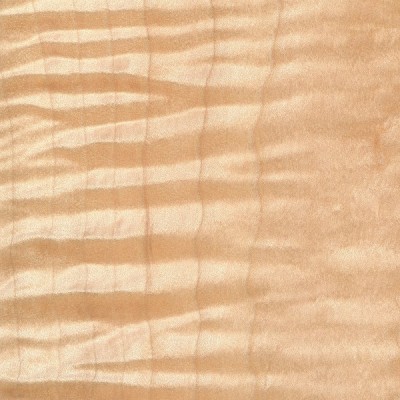
4. Consider the weight and hardness of the wood.
If it’s possible, pick the piece of wood up and get a sense of its weight, and compare it to other known wood species. Try gouging the edge with your fingernail to get a sense of its hardness. If you have a scale, you can take measurements of the length, width, and thickness of the wood, and combine them to find the density of the wood. This can be helpful to compare to other density readings found in the database. When examining the wood in question, compare it to other known wood species, and ask yourself these questions:
Is the wood dry?
Wood from freshly felled trees, or wood that has been stored in an extremely humid environment will have very high moisture contents. In some freshly sawn pieces, moisture could account for over half of the wood’s total weight! Likewise, wood that has been stored in extremely dry conditions of less than 25% relative humidity will most likely feel lighter than average.
How does the wood’s weight compare to other species?
Taking into account the size of the board, how does its weight compare to other benchmark woods? Is it heavier than oak? Is it lighter than pine? Look at the weight numbers for a few wood species that are close to yours, and get a ballpark estimate of its weight.
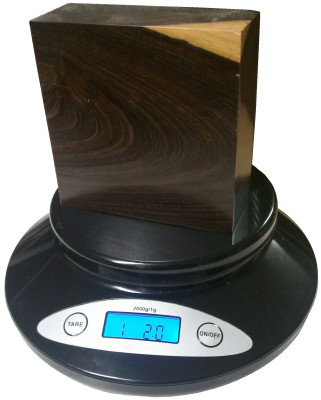
How hard is the wood?
Obviously softwoods will tend to be softer than hardwoods, but try to get a sense of how it compares to other known woods. Density and hardness are closely related, so if the wood is heavy, it will most likely be hard too. If the wood is a part of a finished item that you can’t adequately weigh, you might be able to test the hardness by gouging it in an inconspicuous area. Also, if it is used in a piece of furniture, such as a tabletop, a general idea of its hardness can be assessed by the number and depth of the gouges/dings in the piece given its age and use. A tabletop made of pine will have much deeper dents than a tabletop made of Oak. Additionally, you can always try the “fingernail test” as a rough hardness indicator: find a crisp edge of the wood, and with your fingernail try to push in as hard as you can and see if you’re able to make a dent in the wood.
5. Consider its history.
Many times we forget common sense and logic when attempting to identify wood. If you’ve got a piece of Amish furniture from Pennsylvania, chances are more likely that the wood will be made of something like black walnut or cherry, and not African wenge or jatoba. You might call it “wood profiling,” but sometimes it can pay to be a little prejudiced when it comes to wood identification. Some common-sense questions to ask yourself when trying to identify a piece of wood:
Where did it come from?
Knowing as much as you can about the source of the wood—even the smallest details—can be helpful. If the wood came from a wood pile or a lumber mill where all the pieces were from trees processed locally, then the potential species are immediately limited. If the wood came from a builder of antique furniture, or a boat-builder, or a trim carpenter: each of these occupations will tend to use certain species of woods much more often than others, making a logical guess much simpler.
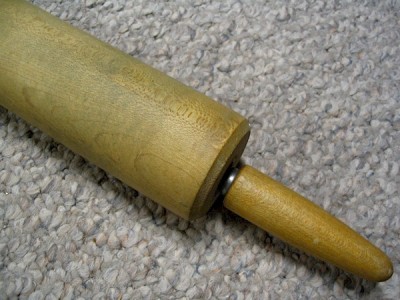
How old is it?
As with the wood’s source, its age will also help in identification purposes. Not only will it help to determine if the wood should have developed a natural patina, but it will also suggest certain species which were more prevalent at different times in history. For instance, many acoustic guitars made before the 1990s have featured Brazilian rosewood backs/sides, yet due to CITES restrictions placed upon that species, East Indian rosewood became a much more common species on newer guitars. (And this is a continuing shift as newer replacements are sought for rosewoods altogether.)
How large is the piece of wood?
Some species of trees are typically very small—some are even considered shrubs—while others get quite large. For instance, if you see a large panel or section of wood that’s entirely black, chances are it’s either painted, dyed, or stained: Gaboon ebony and related species are typically very small and very expensive.
What is the wood’s intended use?
Simply knowing what the wood was intended for—when considered in conjunction with where it came from and how old it is—can give you many clues to help identify it. In some applications, certain wood species are used much more frequently than others, so that you can make an educated guess as to the species of the wood based upon the application where it was used. For instance, in the United States: many older houses with solid hardwood floors have commonly used either red oak or hard maple; many antique furniture pieces have featured quartersawn white oak; many violins have spruce tops; many closet items used aromatic red cedar, and so forth. While it’s not a 100% guarantee, “profiling” the wood in question will help reduce the number of possible suspects, and aid in deducing the correct species.
6. Find the X-Factor.
Sometimes, after all the normal characteristics of a sample have been considered, the identity of the wood in question is still not apparent. In these instances—particularly in situations where a sample has been narrowed down to only a few possible remaining choices—it’s sometimes helpful to bring in specialized tests and other narrower means of identification.
The following techniques and recommendations don’t necessarily have a wide application in initially sorting out wood species and eliminating large swaths of wood species, but will most likely be of use only as a final step in special identification circumstances.
Odor
Believe it or not, freshly machined wood can have a very identifiable scent. When your eyes and hands can’t quite get a definitive answer, sometimes your nose can. Assuming there is no stain, finish, or preservative on or in the wood, quickly sand, saw, or otherwise machine a section of the wood in question, and take a whiff of the aroma.
Although new scents can be very difficult to express in words, many times the scent of an unknown wood may be similar to other known scents. For instance, rosewoods (Dalbergia spp.) are so named for their characteristic odor that is reminiscent of roses. Although difficult to directly communicate, with enough firsthand experience scents can become a memorable and powerful means of wood identification.
Fluorescence
While certain woods can appear basically identical to one another under normal lighting conditions, when exposed to certain wavelengths—such as those found in blacklights—the wood will absorb and emit light in a different (visible) wavelength. This phenomenon is known as fluorescence, and certain woods can be distinguished by the presence or absence of their fluorescent qualities. See the article Fluorescence: A Secret Weapon in Wood Identification for more information.
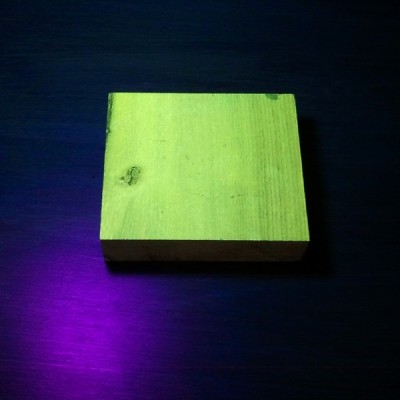
Chemical Testing
There are only a small number of chemical tests regularly used on wood, most of which are very specialized and were developed to help distinguish easily confused species with one another. They work by detecting differences in the composition of heartwood extractives. A chemical substance (called a reagent) is usually dissolved in water and applied to the wood surface: the surface is then observed for any type of chemical reaction (and accompanying color change) that may occur. Two of the most useful are the tests that are meant to separate Red and White Oak, and Red and Hard Maple.
Heartwood Extractives Leachability
Sometimes a wood species will have heartwood extractives that will be readily leachable in water and capable of conspicuously tinting a solution of water a specific color. For instance, the heartwood extractives contained in osage orange (Maclura pomifera) contain a yellowish-brown dye that is soluble in water. (This can sometimes be observed anecdotally when the wood is glued with a water-based adhesive: the glue’s squeeze-out is an unusually vibrant yellow.)
In a simple water extract color test, wood shavings are mixed with water in a vial, test tube, or other suitably small container, and the color of the water is observed after a few minutes. If the heartwood extractives are leachable by water, then a corresponding color change should quickly occur.
In addition to osage orange (Maclura pomifera), merbau (Intsia spp.), and rengas (Gluta spp. and Melanorrhoea spp.) are also noted for their readily leachable heartwood extractives. Because this property is quite uncommon, it can serve to quickly differentiate these woods from other lookalikes.
7. Look at the endgrain.
Perhaps no other technique for accurate identification of wood is as helpful and conclusive as the magnified examination of the endgrain. Frequently, it brings the identification process from a mostly intuitive, unscientific process into a predictable, repeatable, and reliable procedure.
Looking at the endgrain with a magnifier shouldn’t be a mystifying or esoteric art. In many cases, it’s nearly as simple as examining small newsprint under a magnifying glass. There are three components necessary to reap the full benefits contained in the endgrain:
I. A prepared surface.
When working with wood in most capacities, it becomes quickly apparent that endgrain surfaces are not nearly as cooperative or as easily worked as face grain surfaces. However, in this case, it is absolutely critical that a clear and refined endgrain surface is obtained.
For a quick glance of a softwood sample, a very sharp knife or razor blade can be used to take a fresh slice from the endgrain. However, in many denser species, especially in tropical hardwoods, one of the best ways to obtain a clear endgrain view is through diligent sanding. It’s usually best to begin with a relatively smooth saw cut (as from a fine-toothed miter saw blade) and proceed through the grits, starting at around 100, and working up to at least 220 or 320 grit, preferably higher for the cleanest view.
II. The right magnifier.
It need not be expensive, but whatever tool is used to view the endgrain should have adequate magnifying power. In most instances, 10x magnification is ideal, however, anything within the range of 8 to 15x magnification should be suitable for endgrain viewing. (Standard magnifying glasses are typically in the range of 2 to 4x magnification.)
These stronger magnifiers, sometimes called loupes, usually have a smaller viewing area than standard magnifying glasses. Fancier models—with built in lights, or larger viewing surfaces—are available at a premium; but the most basic models are usually only a few dollars.
III. A trained eye.
The third element that constitutes a proper endgrain examination is simply knowing what to look for. In analyzing the patterns, colors, shapes, and spacing of the various anatomical features, there is a veritable storehouse of information within the endgrain—all waiting to be unlocked. Yet, if these elements have not been pointed out and learned, the array of features will simply seem like an unintelligible jumble. The discipline of recognizing anatomical endgrain features is not easily summed up in a few sentences or even a few paragraphs, but it is nonetheless critical to the identification process. To this end, an in-depth look should be given to the various categories, divisions, and elements that constitute endgrain wood identification on the macroscopic level. (In this regard, macroscopic denotes what can be seen with a low-powered, 10x hand lens—without the aid of a microscope—rather than simply what can be seen with the naked eye.) Because the anatomy between softwoods and hardwoods is so divergent, each will be considered and examined separately:Still stumped?
If you have a mysterious piece of wood that you’d like identified, you’ve got a few options for next steps:USDA’s Forest Products Laboratory
You can mail your physical wood samples to the Center for Wood Anatomy Research.
Pros:
- Free
- Professional wood identification
Cons:
- Only available to US citizens
- Slow turnaround times (up to a month or more)
- Limited to three IDs per year
See their Wood ID Factsheet for more info.
Alden Identification Service
You can mail your physical wood samples (even small sections taken from antiques) to Alden Identification Service.
Pros:
- Professional wood identification
- Faster turnaround times (ranging from a few days to a week or two)
Cons:
- Paid service
See their ordering page for more info. (Note that Harry Alden has written several books while at USDA, including both Hardwoods and Softwoods of North America.)
Ask for help online
If the wood ID is merely a curiosity, or non-critical, you can post pictures of the wood in question.
Pros:
- Free
- No need to send physical samples
Cons:
- Greatly limited by the quality of the pictures provided
- Extra work usually required to get adequate clarity in photos
See article of Common US Hardwoods to help find the most commonly used woods.
Get the hard copy
 If you’re interested in getting all that makes The Wood Database unique distilled into a single, real-world resource, there’s the book that’s based on the website—the Amazon.com best-seller, WOOD! Identifying and Using Hundreds of Woods Worldwide. It contains many of the most popular articles found on this website, as well as hundreds of wood profiles—laid out with the same clarity and convenience of the website—packaged in a shop-friendly hardcover book.
If you’re interested in getting all that makes The Wood Database unique distilled into a single, real-world resource, there’s the book that’s based on the website—the Amazon.com best-seller, WOOD! Identifying and Using Hundreds of Woods Worldwide. It contains many of the most popular articles found on this website, as well as hundreds of wood profiles—laid out with the same clarity and convenience of the website—packaged in a shop-friendly hardcover book. 





Why I will no longer be replying to every wood ID request I’ve replied to literally thousands of wood ID requests on this site over the past 13+ years, but as the site’s popularity has grown, so has the time demands for ID on a daily basis. (Contrary to what some may seem to think, I am not some all-knowing wood wizard that can instantly ID your wood. It can actually take me a long time to sift through a lot of different resources.) Over the past few years, my backlog of pending wood species to be added to the… Read more »
Can anyone help with identifying what type of wood this table is.
mahogany
Hi my name is Elizabeth ????? Can someone please help with identifying what type of wood this table might be. Thanking you all in advance for any help you can offer. Your expertise is highly appreciated.
Elizabeth… did you ever find out what kind of wood it is? I have the same looking wood and I am trying to find out as well. I have been told that is looks like beech wood or possibly parawood. I’d love to hear what you’ve found out.
Thanks for sharing your knowledge with us Eric! Coming from somebody so green and eager in the art of wood working, and to learn and acquire the knowledge of those arborists around that are willing to teach, We can’t thank you enough for this information. Even After reading your post I found my self looking through many comments/pics and trying to identify the different species of wood, either to be corrected by your answer or hitting the nail on the head ! Look forward to getting my books soon !
Hi Eric, thanks for your work!
I tried to identify this lumber but could not get reliable results.
I got it from a man who makes cars interior refit :)
Measured density is pretty large – 59-61.5 lb/ft3 (943-985kg/m3)
Do you have any thoughts what this could be?
(This is surface and endgrain images + zoomed sections)
Is there a pronounced odor when sanding this wood? Some type of rosewood is definitely a possibility.
Yes, it has pronounced sweety odor. And it’s definitely some type of rosewood, but which? :)
Can someone tell me if this is real wood? It’s a heavy kitchen table top that looks to be pieced together.
Can’t tell from the picture. It MIGHT be real, and if it is, it would be veneered in what is known as a sunburst pattern. Or it could just be a printed pattern. Can’t tell from the picture and distance.
Someone in another group suggested that this may be made of African mahogany. What do you think?
Here is the slab side.
Any idea of type of wood? Has a redish tint to it.
Never stained or painted. Just sanded. Was very rough and can still see saw marks. Found in South Alabama
I found this board in my grandfathers closet. I made a beach out of it. It’s not stained and was very rough when I found it. All I’ve done to it is sand it. Ring count is 24 or so rings per inch. Was found in South Alabama. Thank you
Hi, I live in WA State, I bought a house with this flooring. The only thing I know is that it is a softwood because it scratches with my fingernail. . One of the previous owners floored most of the house with this but not all of it. I’d like to finish the job with the same kind of wood. The planks are 7″ wide. Also, is this the wood’s natural color or stain? Thanks!
looks like red elm maybe natural color
Hard to say for sure, but I agree it is probably a softwood — not due to softness (Balsa is classified as a hardwood) but grain pattern. If it was harvested locally, the two leading candidates would be Douglas fir and western larch.
Hi, any thoughts on the wood in the attached images of a table? It’s a coffee table that was given as a present almost 20 years ago now. It’s very heavy! Thanks in advance
Hi, any ideas what wood this is
looks like a type of mahogany
Hi Eric do you know what this could be?
looks like sour wood
Hi Eric, Is there any chance you could help identify this wooden parquet blocks for me. I’m needing to locate some more and am struggling to work out the wood. It is fine grained, hardwood (I think) yellow, golden / orangey when waxed. When sanded before waxing it has a warm honey tone. Any help you could give would be great. Thank you, Gill
Possibly birch? Or maple with some heartwood.
As with others, need help, desk and credenza, could be veneer, been told teak, walnut, or oak.
I think oak is out. Cannot get end grain. Mahogany?
Yes it does look veneered judging by the bookmatched panels on top. Some type of mahogany is the most likely. Definitely not walnut oak or teak.
mahogany
Hi Eric,
Can you tell what kind of wood this is? This is an old China cabinet. I can send more pics if needed.
HI Eric,
I am hoping you can help me identify what wood this is . It is the same only that the little stool has not been stained whereas the table has been stained. Would appreciate to know. Thank you
Hi Eric here is an end grain pic of the possible maple, does this help with identification?
I don’t see any evidence of pores in that endgrain image. Unless I am thrown off by the photo, that would suggest a softwood such as fir or hemlock or pine.
Looking for help to identify the wood on our stairs. Need to replace a few treads
Thank you,
My guess would be some type of dense softwood such as Douglas fir or southern yellow pine. You might have an issue finding wood that’s of the same species that’s as dense with growth rings spaced that closely together.
Hi Eric,
I have a desk made by great-grandfather for his daughter who was my grandmother in 1935. They lived in northern Alabama so I assume this was where the desk was made. I have no idea what kind of wood it is although it feels very hard and is heavy. The desk was painted but on the bottom you can see parts of the wood. Any guesses on this? I am thinking of stripping off the old paint and refinishing it. I really love having this desk.
Thanks!
It looks like some nice old growth southern yellow pine.
Hi there
I have these slabs that I am trying to identify. Do you have any idea of what they might be?
Thanks
That surface looks heavily weathered and would need to be sanded to a fine grit to have a better chance at ID.
Hi Eric! I love the site and spent a couple hours educating myself on the hazards of wood ID. I’m refinishing this salvaged coffee table (picked it up on the curb during a big moving day in Boston.) Based on what Ive read and a dash of common sense, I think it’s maple but would love a second opinion! The top feels smooth after sanding (I don’t feel any grains, etc). Thank you so much for sharing your expertise on this site!
l have read your wood identification guide, it is amazing! I have bought a wooden closet that the owner said is made from Peroba Rosa. After reading the guide, I am not sure it is correct. What wood would say it is, based on the picture?
It’s almost impossible to tell from that picture, but as best as I can see, the pores appear to be rather large, peroba rosa has very small pores with a fine texture. Posting a picture of the endgrain (finely sanded) may help with ID.
Hello,I really need to know what wood this strat is made of. :-)
Can’t tell from the picture. At most, I can say that the color superficially resembles mahogany, but it’s hard to say for sure from the picture, I can’t make out the grain clearly enough.
Hello Eric..
I’d like to know what this cigarette box might be made of. After reading through your very informative site (thanks!), I was thinking maybe Cherry because of its resistance to humidity? Would the inside and outside woods be the same, with one finished for decorative purposes?
Thanks so much!
Janice
Definitely not cherry. It looks like an imported tropical wood of some sort. Possibly an Albizia species or something resembling it.
Hi can anyone tell me what this wood is
The curl reminds me of maple, but can’t say for sure from that pic.
Hi can anyone tell me what wood this is
What type wood were older 5 panel mission style solid core doors usually made of in the south
I am stumped by this species of wood in some antique doors that came out of Philadelphia PA. They need some minor repairs and it would be nice to know the type of wood to repair/match better. These are different views/lighting of the doors. They do have finish on the surfaces although the group of 3 end grain photos does not seem to have much finish on it. I would greatly appreciate it if you could point me in the right direction on this type of wood, I would be extremely surprised if it were not a wood native to… Read more »
Looks like stained oak. Most of the challenge in matching the color will be in finding a stain color to match.
Thank you for the reply. I am only familiar with some white oak and red oak I have which both have thin vertical lines showing in the end grain along with not having the same basically horizontal pore trails this wood has in its end grain. I do realize there are other types of oak besides the two I am familiar with. My main concern being if it were another wood it might not take stain and give the same look that oak does (pine for example).
I just went and looked at photos I sent of my end grain again. Although in the photos it might look like this wood also has vertical lines in it, these actually seem to be age cracks to me. I will try to study different types of oak if I can find on your web site. Thank you again !!!
Tough to say since the end grain is so weathered; if you were to take a fresh slice off with a circular saw and get a clean image of the endgrain, things would be much clearer. Drying checks nearly always develop along the rays, so whether it’s lines or cracks, it is more or less the same thing.
If the wood is fairly light and soft, another possibility might be chestnut.
Sorry about my (?) question mark typo— your discussion is *certainly* informative!! Here are a couple more images ov parts of the clock. It would be SO helpful to have a better idea of the type of wood, even if only probable, not certain!
So deeply appreciated!
Andrew
Your discussion is wonderful, so very informative? Hating to impose, would you have some idea about the wood on this clock, manufactured by “Sligh”? They only advertise is as a “cherry finish”, which I suspect is intended to confuse customers into assuming it is solid cherry. So right now it is just generic mystery wood to me. Is is possible it is actual cherry or even mahogany (I doubt it). If they advertise it as “hardwood” (they do), what would a cheap generic candidate be?
Thank you so very much!!!
Andrew
The back looks most like birch plywood that’s been stained. The rest may be something like poplar, hard to tell. To top it all off, I’d say the color of the stain would be more in line with calling it walnut and not cherry.
Thanks! So you’re pretty certain this is cheap wood, nothing premium like cherry? I’ll not buy it if its poplar, but would if cherry (or better or equivalent). Poplar would be a thumbs down. Are you pretty sure its low grade material? Thanks so much for your insight, generously shared!
Can you tell me what kind of wood this is? Also if it’s been treated? I want to use it inside but people on another site told me it looks treated and unsafe to use inside. Thank you!
It does look like a softwood such as pine. The unnaturally dark, almost olive tone to many of the boards are what probably prompted people to comment that it was pressure treated. I don’t know what might be in the wood, but generally it isn’t good stuff (it is supposed to deter bugs and other burrowers from attacking the wood). I know they used to use arsenic to treat wood.
.
This is the second woof picture. It didn’t let me post more than one picture at a time.
Hello, I’m doing a project and am trying to identify the species of wood from a barn in the Cotswolds in the UK. Does anyone know what species these pictures represent?
Hello there Eric
Not sure if you can help me – I am based in England and have been given an ornate American rocking chair to restore/upholster. Can you please advise if you can id the wood? I heard they were commonly made with cherry , walnut or oak …I really cannot tell which. Thanks Jane
Definitely isn’t oak. To me, it actually looks closer to mahogany, but can’t tell from this picture. Can you get another picture of a flat part of the wood — is the seat portion visible underneath?
Great read, thanks for posting. Was wondering if you could tell me what kind of wood I have here. Thank you!
Can’t say with complete certainty without seeing the end grain, but I’m going to guess you have a type of soft pine, especially based on what appears to be very large resin canals visible on the face grain. https://www.wood-database.com/wood-articles/pine-wood-an-overall-guide/
Thanks for the reply. Here is a photo of the end grain…
Endgrain photo more or less confirms previous comment: soft pine.
Great. Thank you.
Can u guys tell me what kind of wood this is? I found it and milled it but idk what kind it is.
Can anyone tell me what wood this is? Its a sold wood.
Hard to tell from that distance, but my guess would be walnut.
This is wonderful Thanks for your work.
I have an old table so the end grain is glopped with finish but I found underneath there is less/ no finish and a place where a trim piece was removed from the leaf, and I also include a pic of the side grain where the leaf and top hinge. I believe that it is solid and the grain on the top makes it appear joined boards. The top is about 2’x4′. Can you determine the wood?
Thanks much.
Possibly stained mahogany
Trying to replace a door – can you tell me what type of wood and finish this is?
Can you i.d the wood of this side table top. I would like to remove (sandpaper or decap?) the transparent lacker and make it a bit darker, a more red, deeper tone colour . What should I use: varnish , colour – wax…? Some advice would be much appreciated. Regards
Looks like Beech in colour
Thank you Dave
I made a soap dish out of an off cut I got in a scrapwood bundle box but I’m not sure what it is. Moderately heavy for its size and pretty hard. It just has a mineral oil finish, so that is it’s natural color and grain.
To me, that looks most like soft maple, which can be a slightly darker amber color sometimes. Are you on the west coast? If so, it could be bigleaf maple.
can you tell me what type of wood this is? It originally was a reddish brown. it is really hard and after sanding to 800 has this white haze on it after wiping it with a wet rag.
I could be wrong as it’s hard to tell from the photo, but the white haze you describe could simply be tearout from the turning process. Endgrain can be difficult to sand thoroughly enough. But I do see sections of tearout that warrant more sanding, starting with a very coarse grit. If you could get a closeup pic of the endgrain it might give more clues to ID.
Hi. Would you be able to identify type of wood used for this unit. Its heavy and partially sanded. I would be very grateful
Thank you
Monika
Hard to tell from the picture, but the most likely candidate would be stained oak.
Thank you very much:-)
Help with this unplaned and finished piece of Walnut or Mahogany? Something else?
Another pic
Hard to tell from the picture, but the most likely candidate would be stained oak.
Hi Eric, I’m hoping you can help me with your expertise and identify this particular timber species from reclaimed building materials I found and cleaned recently in Sydney, Australia?
Sorry, Australian species are a challenge for me! Right off the bat, just going by the numbers, you could potentially narrow it down to either Eucalyptus or Acacia. If you test for fluorescence with a blacklight it might help as well as lots of Acacias respond (glow) to blacklight.
And here is a picture of the lighter boards end grain. I also included the side of the board because it has some interesting qualities
With that closer look, looks like its cherry after all!
Thank you so much, I really appreciate it. I’m definitely going to educate myself on grain types and characteristics. Now all I have to do is think of what to make this into. Thanks again
Thanks for the quick reply, I really appreciate it. Here is a picture of the end grain of the darker two. I took a picture from both sides one side I sanded hope it helps